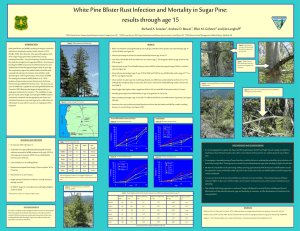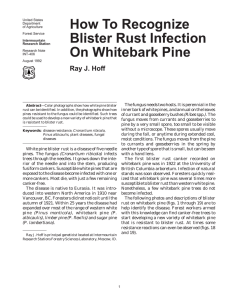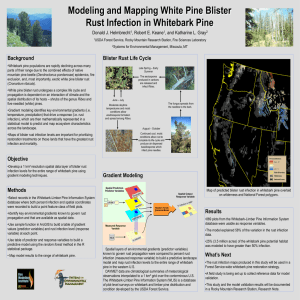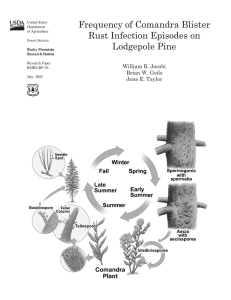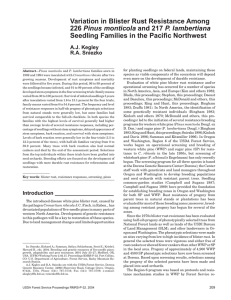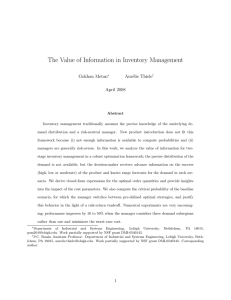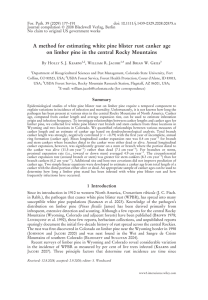Field Results of White Pine Blister Western White Pine Seedlings
advertisement
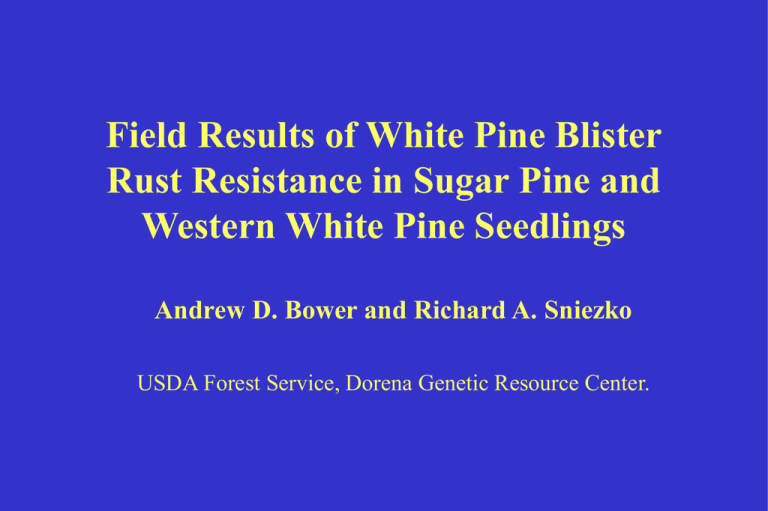
Field Results of White Pine Blister Rust Resistance in Sugar Pine and Western White Pine Seedlings Andrew D. Bower and Richard A. Sniezko USDA Forest Service, Dorena Genetic Resource Center. Field Results of White Pine Blister Rust Resistance in Sugar Pine and Western White Pine Seedlings • • • • • • • Background Introduction Objectives Materials and Methods Results Discussion Conclusions Background • White pine blister rust (Cronartium ribicola) (WPBR) introduced to western N. America in 1910. • WPBR affects western white pine (WWP)(Pinus monticola), sugar pine (SP)(P. lambertiana) and other 5 needle pines. • Alternate hosts are Ribes spp. • Produces a diamond-shape canker that eventually can girdle the stem, killing the tree. • Low level of naturally occurring resistance. • Major Gene Resistance and virulent strains of rust. Introduction • USDA Forest Service has been screening WWP and SP for WPBR resistance since the 1950’s. • Progeny of over 10,000 phenotypic selections have been tested at the Dorena Genetic Resource Center (DGRC). • <5% of these selections have >30% canker-free progeny, and 95% of the seedlings develop lesions and die within the 5-year evaluation period. Objectives • Investigation of field performance of progeny of individuals selected in short-term screening. • Field validation of resistance mechanisms observed in artificial screening. • Examination of the gains from WPBR resistance screening and breeding. Materials and Methods • Established in Spring 1996 at Happy Camp, California, with 1-0 container stock. • 12 SP and 13 WWP families of varying resistance levels. • 12 blocks. • Randomized complete-block design. • 4 tree row-plots, each family represented once in each block. Measurements • • • • • Height Number of cankers on bole Type and number of infections Damage Tree vigor Stem Infection Types • Normal (N) – active stem infection. • Bark Reaction (BR) – canker inactive or “corked out”. • Partial Bark Reaction (PBR) – bark reaction with some area of canker still alive. • Blight (BL) – inactive canker on a branch that was killed. Analysis • ANOVA used to test for differences between species and among families within a species. – Infection % (using rep means) – Height (using individuals) – # infections per tree (using individuals) • X2 test of independence to determine presence of an association between species and stem infection type. Results Results of analysis comparing species published as part of the proceedings of the “Ribes, Pines, and White Pine Blister Rust Conference” in Corvallis, Oregon. September 8-10, 1999. HortTechnology 10(3):519-522 Survival and Growth # Planted # Surviving % Survival Height SP WWP 560 555 99.1% 34.8” (88.5cm) 616 607 98.5% 29.8” (75.6cm) Infection Percent SP WWP % of living trees infected 70.2% 34.3% % with only 1 canker 27.5% 21.8% % with >1 canker 42.7% 12.5% Infection SP WWP Total # of cankers 953 356 Total # of infected trees 393 211 Mean # Infections/tree (infected trees only) Range 2.42 1.69 0-17 0-9 Species Difference Results P-value Source % Infection Height # Cankers Block 0.0068** 0.0829* 0.1433 Species 0.0001** 0.0005** 0.0014** - 0.0326** 0.2697 BxS * Significant and a = 0.1 ** Significant and a = 0.05 Family Analysis Results P-value Source % Infection Height # Cankers Block 0.0068** 0.0063** 0.0975* Species 0.0001** 0.0019** 0.0001** 0.8444 0.2815 0.0893* 0.0001** 0.0001** 0.1714 - 0.0001** 0.0001** BxS Family(S) B x F(S) Observed and expected # of stem infections Sugar Pine Western White Pine Obs. Exp. Obs. Exp. Total Normal PBR BR BL Total 256 (26.9%) 267 111 (31.2%) 100 367 134 (14.1%) 148 69 (19.4%) 55 203 394 (41.3%) 370 114 (32.0%) 138 508 169 (17.7%) 168 62 (17.4%) 63 231 953 356 C2 test for independence = 12.272, P = 0.007 1309 Bark Reaction • High incidence of Bark Reaction NOT expected. Mean of family means SP WWP % BR in screening 13.2 28.4 % BR in field 60.9 25.4 0.336 -0.270 Correlation Discussion • Reason for high incidence of BR unknown. • Hunt (1997) isolated several different fungi types from BR phenotypes in WWP. – Most common was phoma wilt (Phoma herbarum), which produces lesions identical to BR • BR has been shown to be real and repeatable. • Other confounding biological or environmental factors causing high level of BR. Conclusions • SP more susceptible than WWP at this site. • Significant differences between species exist for infection percentage, height, and number of cankers/tree. • Significant differences among families within a species exist for infection percentage, and height only. Conclusions • Both species exhibit moderate levels of BR. • A significant association exists between species and infection type. N PBR BR SP < exp. < exp. > exp. WWP > exp. > exp. < exp. • Low correlation between family mean BR % in screening and field site. Future Assessment • 5th year measurements currently under way. • Differential rates of mortality following infection. • Long term differences in BR and tolerance between species and families with species. • Essential validation of results of artificial inoculation tests. • Information on current gains in rust resistance from seed orchards. Acknowledgements • Dean Davis, and Deems Burton. • Dr. B. B. Kinloch and Dr. R. Westfall • Lee Riley, Jude Danielson, Bob Danchok, Sally Long, and Ann Willyard. • USDA Forest Service, Forest Health and Protection Program

